Written by: Ashley Vicari, NCC, LPC (she/her)
Professional Relations Manager

In the media, the most common clinical eating disorders usually get coverage, however there are various other eating disorders and disordered eating patterns that can cause significant impairment psychologically, medically, and socially. Recognizing the signs and symptoms of these lesser-known issues is the first step in receiving support you may need and deserve.
Lesser-Known Eating Disorders
In this post, we review a list of terms and definitions of lesser-known feeding and eating disorders. It is important to note that some of these terms do not have official diagnostic criteria and may fall under the larger umbrella of Other Specified Feeding and Eating Disorder (OSFED). If any of the signs and symptoms below resonate with you or a loved one, please reach out for help. If there is a desire to improve your relationship with food or your body, you do not need to meet the strict criteria for a clinical eating disorder to benefit from professional support.
THE DSM-5
The American Psychiatric Association has published the Diagnostic and Statistical Manual of Mental Disorders (DSM-5) and defines feeding and eating disorders as: “a persistent disturbance of eating or eating-related behavior that results in the altered consumption or absorption of food and that significantly impairs physical health or psychosocial functioning.” (pg. 329)
What is ARFID?
ARFID stands for Avoidant Restrictive Food Intake Disorder. Traditionally, we may have seen this referred to as “extreme picky eating.” The DSM-5 criteria define it as: A lack of interest/avoidance in eating food based on the sensory characteristics of the food or concern about the aversive consequences of eating the food such as choking or having an allergic reaction, creating an inability to meet appropriate nutritional needs.
In terms of symptoms, we may see one or more of the following:
- Significant weight loss
- Significant nutritional deficiency
- A dependance of supplements for nutrients
- Marked interference with psychosocial functioning.
What is OSFED?
OSFED stands for Other Specified Feeding and Eating Disorders. This category was developed to encapsulate the eating disorder symptoms that we know exist, but do not perfectly fit the strict criteria for the more well-known eating disorders such as Anorexia Nervosa, Bulimia Nervosa, Binge Eating Disorder, and/or ARFID. OSFED causes significant distress and impairment in social, occupational, and other important areas of functioning, as well as an overevaluation of shape and weight.
Nutritional needs will not be met. Here are two examples of OSFED diagnoses:
- Atypical Anorexia: Diagnostically occurs when someone meets all criteria for anorexia nervosa including restriction of nutritional needs to function and extreme fear of gaining weight resulting in an overevaluation of shape and weight, however the individual’s weight may be within or above “normal” range.
- Night Eating Syndrome: The key criteria for night eating syndrome are recurrent episodes of eating at night either after the evening meal or waking from sleep to eat. The individual is aware of and can recall each episode. Thus, this is not an episode of sleep eating/walking. The individual will have significant distress and/or impairment of functioning as it pertains to the night eating.
[For more, check out our Podcast Episode, Lesser-Known Eating Disorders Part 1]
What Are Non-Clinical Eating Disorders?
Some eating issues and disordered eating patterns are not included in the DSM-5, yet their symptoms often result in significant distress and serious impairment across various domains. Many of these terms were created by the media to describe a very specific set of experiences involving food and/or body image, however these symptoms will often fit the criteria for a broader eating disorder diagnosis, such as OSFED.
Orthorexia
A term used to describe an obsession with “proper/healthy/clean eating”. Although this term is not yet in the DSM-5 as a diagnosable disorder, the symptoms may meet criteria for OSFED or Anorexia. Orthorexia is frequently characterized by:
- Significant nutritional deficiency and/or significant weight loss due to nutritional deficiency
- An overevaluation of a narrow group of foods that would be classified as “healthy,” and restricting/cutting out entire food groups labeled as “unhealthy” such as: all sugar, all carbs, all dairy, all meat, all animal products, etc.
- Heightened interest in what others are consuming, and/or obsessive following of “healthy/healthy lifestyle” accounts on blogs and social media.
- Concerns regarding body image and weight may or may not be present.
Diabulimia
A term used to describe an individual with diabetes (usually type-1 diabetes) who may be restricting or limiting insulin doses in an effort to lose weight. Those struggling with diabulimia will sometimes meet diagnostic criteria for a more well-known eating disorder. For example, if the restriction of insulin is conceptualized as an attempt to compensate for binge eating episodes, a diagnosis of bulimia might fit. The individual may present as malnourished and may develop serious medical complications due to their symptoms. Similar to most eating disorders, an overevaluation of shape and weight is present.
Drunkorexia or Food and Alcohol Disturbance (FAD)
May describe an individual with both a diagnosable Substance Use Disorder and an eating disorder. In an attempt to avoid weight gain the individual may save calories during the day in an effort to binge drink later. This can cause extreme impairment in functioning and can be associated with anxiety, depression, and other mental health diagnoses.
Bigorexia
Although Bigorexia is not a formal psychiatric diagnosis in the DSM-5, the set of symptoms and experiences around food and body image may fall under the category of “Body Dysmorphic Disorder” and/or a clinical eating disorder.
- The individual is preoccupied with the idea that their body build is too small or insufficiently muscular. This individual may see flaws or defects not otherwise seen by others.
- This individual may be pre-occupied with behaviors such as body checking, pinching, comparing, reassurance seeking, and mirror checking.
- They may obsess about their diet in an effort to increase muscle mass and/or decrease body fat percentages.
- The preoccupation causes significant distress or impairment in social, occupational, or other areas of functioning.
[For more, check out our Podcast Episode, Lesser-Known Eating Disorders Part 2]
Conclusion
It is important to note that regardless of the diagnostic label that is assigned, if your relationship with food and/or your body is negatively impacting your life or the life of a loved one, seeking help may be the best route. Starting with a therapist and dietician trained in eating disorder work can be highly beneficial. Please reach out to us at 1-800-RENFREW to get connected with your local resources such as therapists, dietitians, psychiatrists, or medical providers. You may also visit us online at to take our quizzes or download resources. We’re here to help you and your support system better understand the signs and symptoms of eating disorders and disordered eating and access the support you deserve.
Resources:
APA, DSM-5, and The Cleveland Clinic



